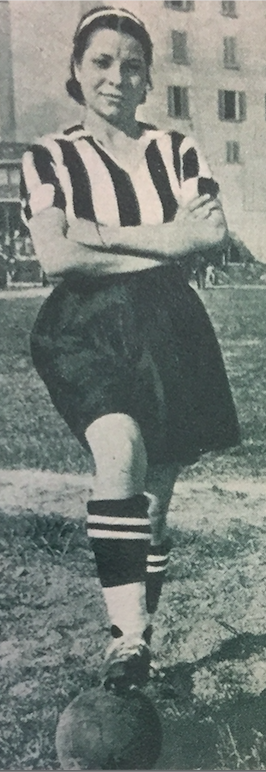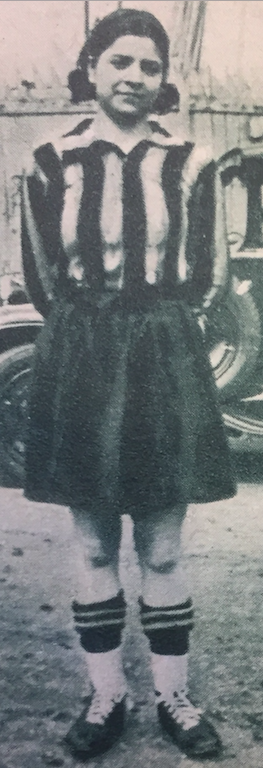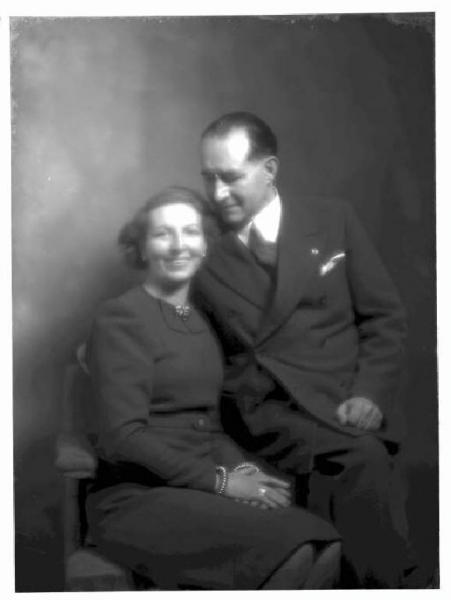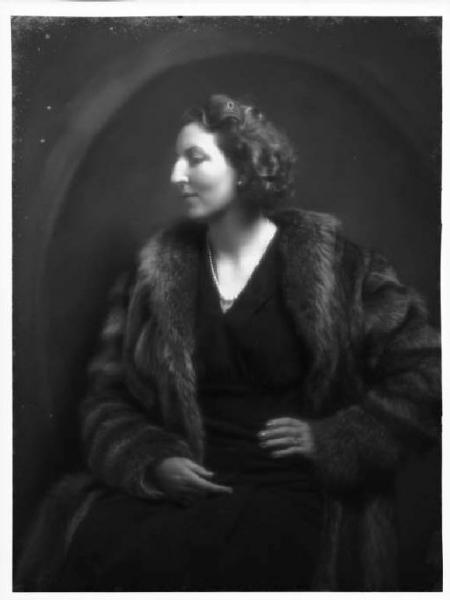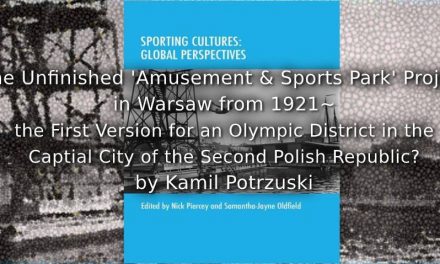Some Playing Pasts readers may wonder what happened to the calciatrici of Gruppo Femminile Calcistico [GFC], after the Fascist regime established, in Autumn 1933, that football was no longer suitable for Italian women. As we already know [see http://bit.ly/2FU7NuX], on 1 October 1933 the first-ever national women’s football match was scheduled in Alessandria: the Milanese calciatrici were expected to play against the local female players led by Amelia Piccinini. Two days before, the match was banned by the local Fascist authorities: Rosetta Boccalini and all her GFC teammates had to give up their exciting first-ever trip to Piedmont.
Meanwhile, on that Sunday [1 October 1933], two men approached the Milanese sports pitch where Rosetta, Brunilde Amodeo and all the calciatrici were training. Ermanno Carnevali and Bruno Valmori, two card-carrying coaches of the Italian Athletics Federation (FIDAL), suggested a new challenge: why don’t you all race 50m? The girls accepted: Maria Lucchese, Ester Dal Pan, Ninì Zanetti [and Franca Agorni, who was perhaps brought there by the FIDAL coaches, since her name can’t be found among GFC sources] were the fastest, recording about 8′. Carnevali and Valmori said that the best of the calciatrici could become good runners, after undertaking some hard training. So the Gruppo Atletico Femminile ‘Female Athletics Group’ was founded: and any girls eager to join, could write to the group headquarters, located in the same via Stoppani 12 where the Ugo Cardosi wine shop and GFC headquarters were located. The first training session [50m and 100m] was scheduled for following Sunday, 8 October 1933.
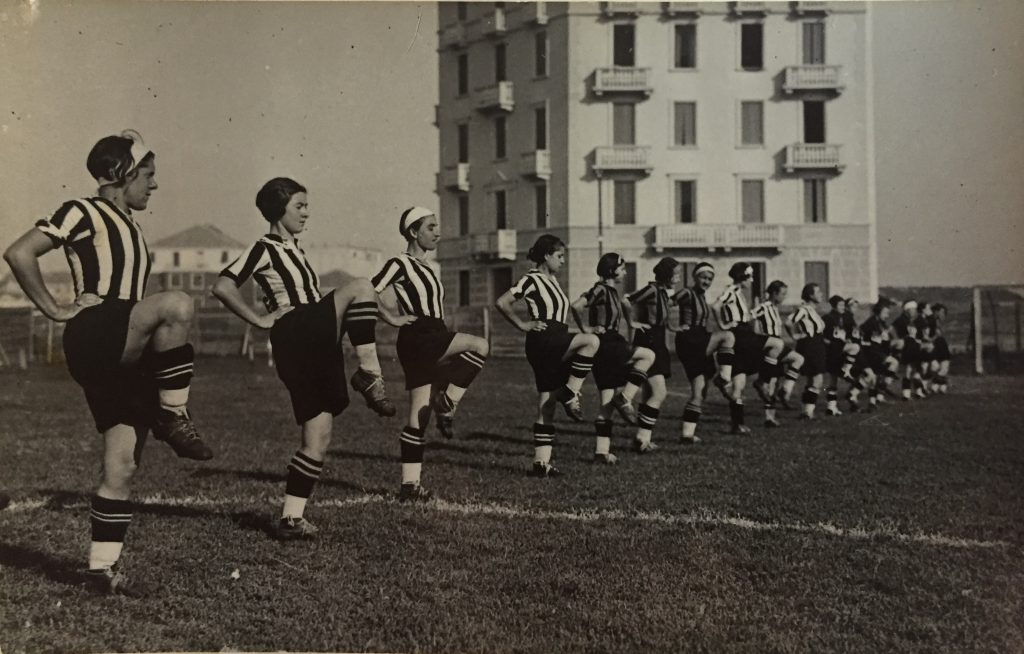
GFC’s warm-up
Source: Archivio privato Rosa Mottino.
Then something seems to go wrong, but unfortunately there is little information about the Gruppo Atletico Femminile during the intervening weeks. While the last calciatrici tried desperately to play football until the beginning of December, Ninì Zanetti wrote to the Forza e Coraggio sporting centre to ask the local managers if they would welcome some girls eager to partake in athletics and basketball? We know that the Forza e Coraggio managers contacted Ninì to discuss this, but nothing is known regarding the outcome of this meeting. [see https://bit.ly/2RgfZve]
In the regime’s view, Milan had to establish a women’s athletics group, such as cities of Turin, Bologna and Trieste had done. The Berlin Olympics were approaching fast and Italy needed to win some female medals, so during 1933 the new Italian Olympic Committee [CONI] President Achille Starace [who was also the Secretary of the National Fascist Party] ordered all Italian athletics, swimming, fencing, and basketball clubs to instigate female sections. The Milanese girls proved quite promising, the local team having been victorious at the special female events held during the 1933 Littoriali ‘University Games’, held in Turin. “Nevertheless, there were still no women’s athletics clubs in town, while the GFC calciatrici were spending their precious energy and time playing ‘useless’ football, the ‘boys’ game’ …”
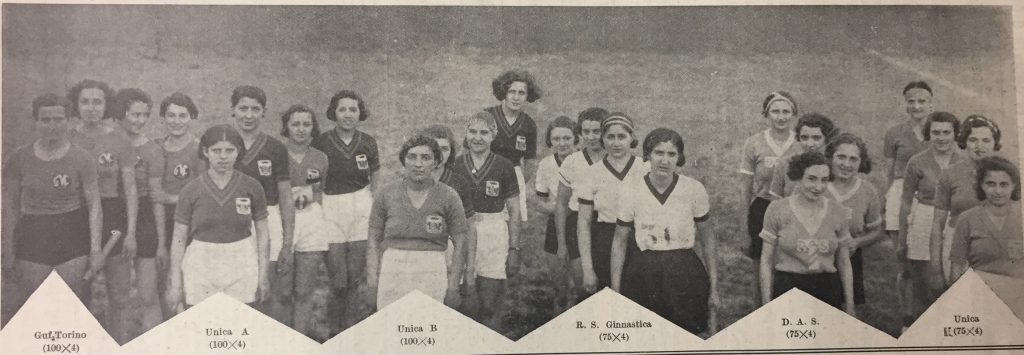
Promoting women’s athletics during the Thirties was a creative job, according to FIDAL biweekly “Atletica Leggera” graphic designer … Here’s a roundup of Turinese women’s relays, coming from local clubs such as Venchi-Unica, DAS, Reale Società Ginnastica and Guf ‘Fascist university group’.
Source: Atletica Leggera, 31/05/1934, p. 16.
During the Summer of 1934. the Milanese sports weekly La Domenica Sportiva[ [the same publication that, two years previously, had published the famous Nini Zanett letter in which she wondered why shouldn’t Italian girls shouldn’t play football] included some photos of the new women’s sports society; Gruppo Sportivo Giovinezza (GSG), established ‘some months’ before in … via Stoppani 12, of course! Although several basketball players are still wearing the same football shirts they wore as GFC players, their transformation has already begun, as can be seen by their white, basketball shoes and despite the football goal in the background of the last picture. Their training ground was the Campo ‘field’ Giuriati, located in Città Studi ‘university district’ of the city.
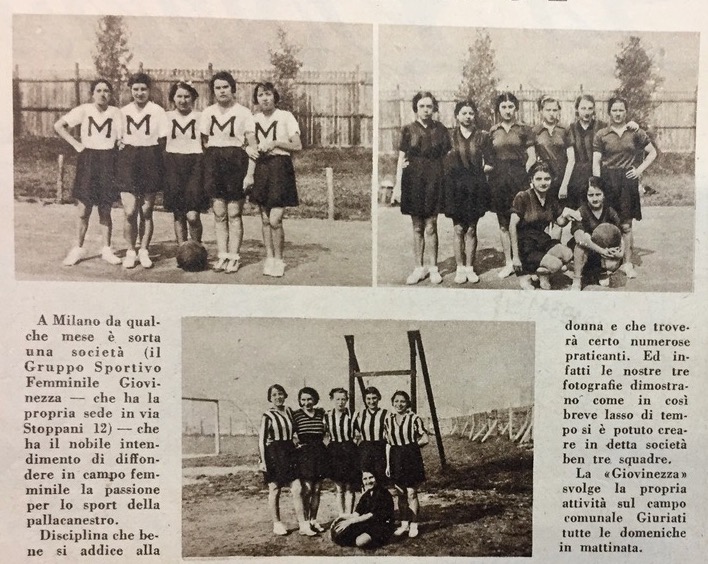
The first-ever photos of GSG basket teams: the M team, the black-and-blue team & the black-and-white team.
Graziella Lucchese is standing 2nd from left in the 2nd picture and her elder sister Maria is standing 1st from right in the 3rd picture
Source: La Domenica Sportiva, 08/06/1934, p. 15
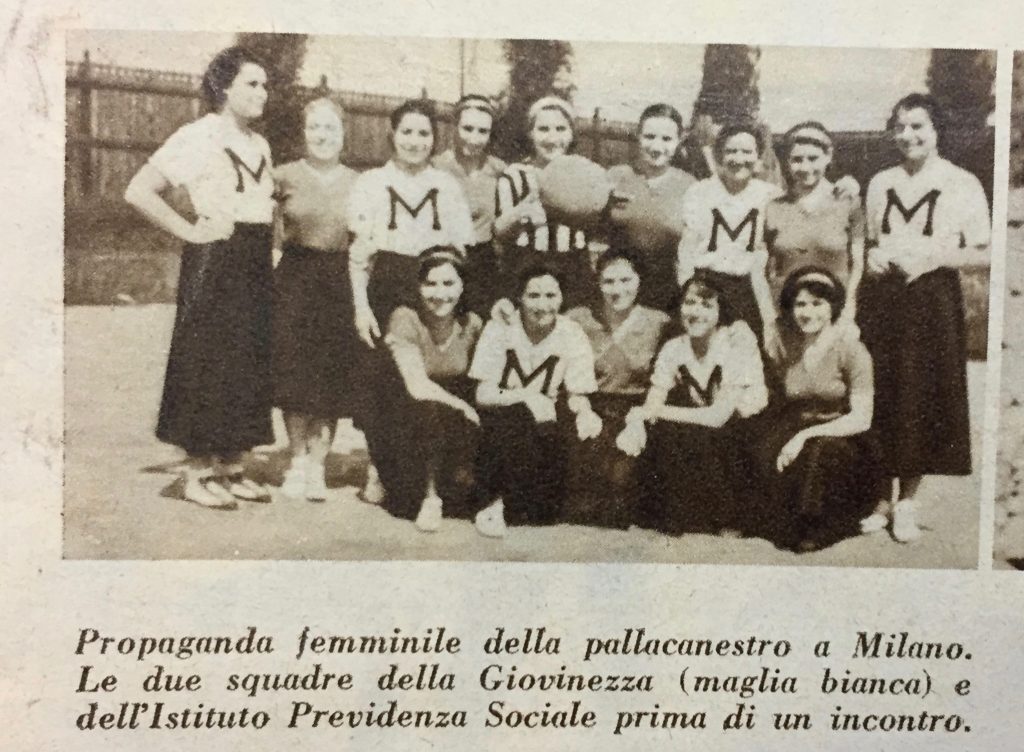
Original caption talks about GSG and Istituto Previdenza Sociale team players, the first ones wearing a ‘white shirt’
Source: La Domenica Sportiva, 05/08/1934, p. 15
Maria, and Graziella Lucchese as GFC footballers. Source: Il Calcio Illustrato, 26/07/1933, p. 7.
Finally, in October 1934, after further months of media silence, the news of the official establishment of the GSG began to circulate. This new Milanese women’s sports society had two internal sections [athletics, and basketball], the managers were coach Cifarelli and, in overall charge Mrs Teruzzi, the cousin of the powerful Fascist gerarca Attilio Teruzzi in front of whose mansion, Villa Celestina, Ninì Zanetti and her friends tried, in the Summer of 1932 to play football [see http://bit.ly/2FU7NuX ]. Cifarelli successfully succeeded in inviting GS Venchi-Unica (Turin) to come to Milan, so the best women’s sports society in Italy was going to ensure that the Milanese rookies had a baptism of fire, at an event scheduled for Sunday 4 November 1934.
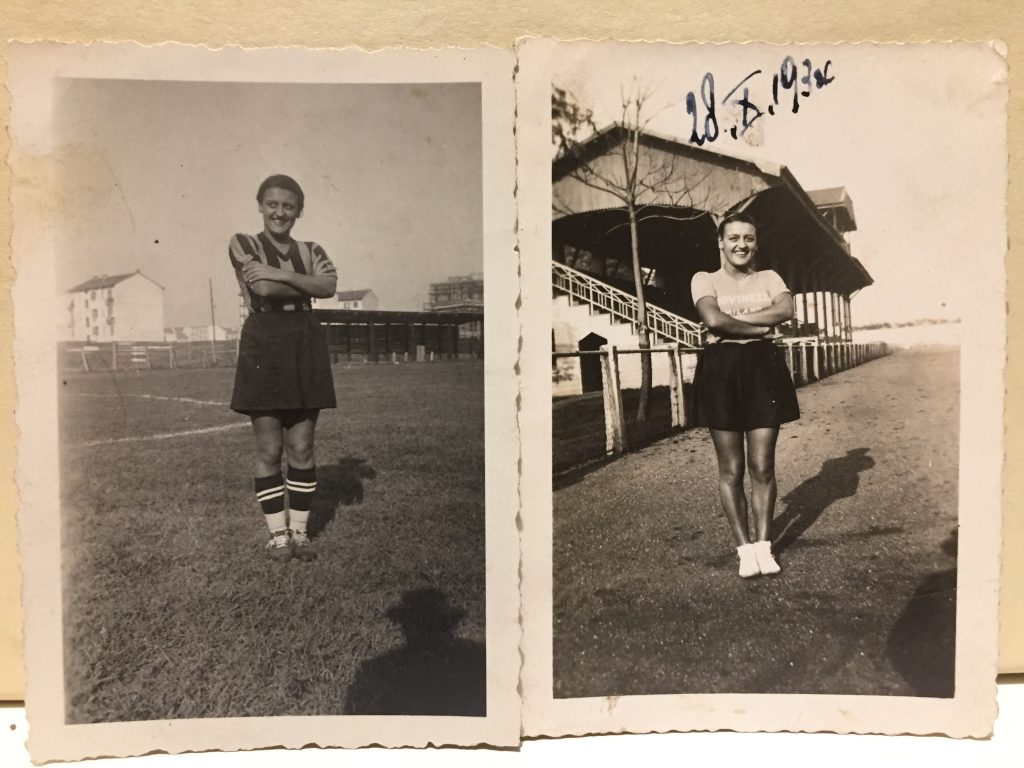
Brunilde Amodeo transformation, from GFC calciatrice [1933] to GSG athlete [1934]
Source: Archivio private Brunella Bracardi (courtesy to Francesco Bacigalupo)
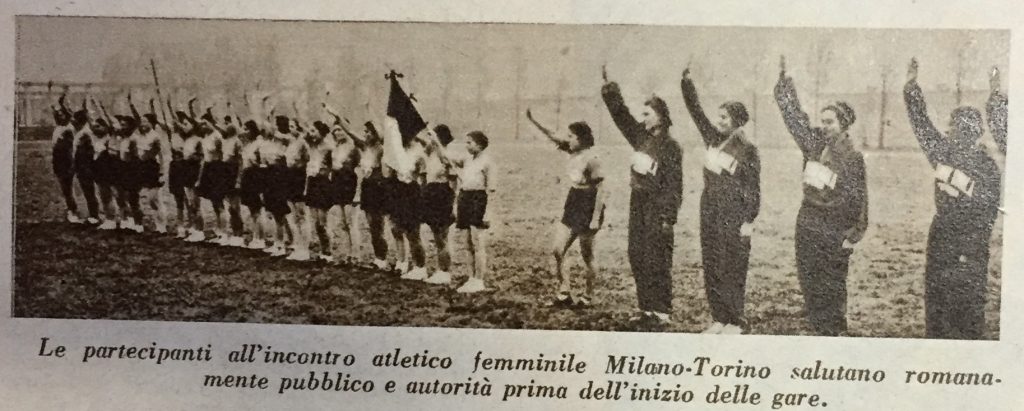
GSG and GS Venchi-Unica performing the Roman salute to the public before the November athletic meeting. According to surviving sources, GFC calciatrici didn’t perform the salute before their football matches – but they carried an Italian flag, like the GSG athletes. Note that the Milanese girls had no team uniform, unlike their more professional opponents. Source: La Domenica Sportiva, 11/11/1934, p. 12.
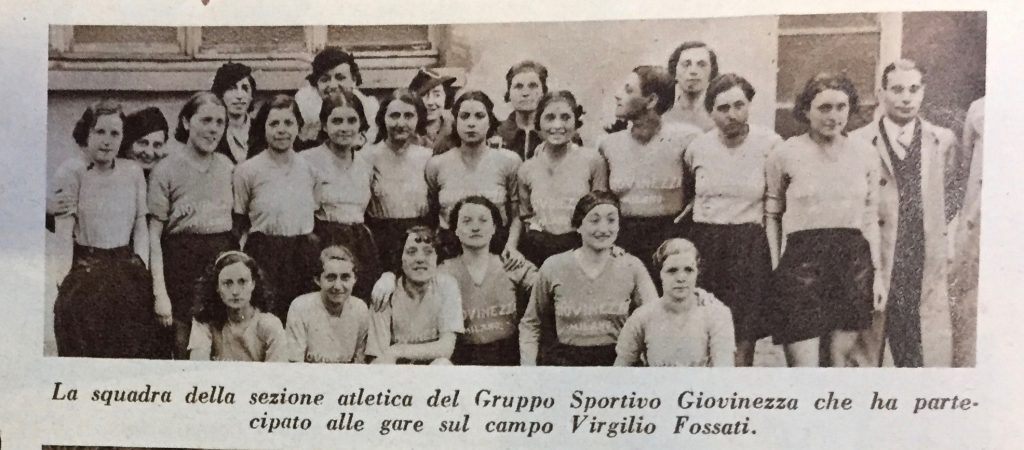
16 GSG athletes, among which are – Ninì Zanetti [standing 2nd left], Graziella Lucchese [3rd], Maria Lucchese [6th], Brunilde Amodeo [8th, in profile].
Note the ‘friends’ in plain clothes. in the background 4th from left could be former GFC player Ester Dal Pan.
Source: La Domenica Sportiva, 11/11/1934, p. 12.
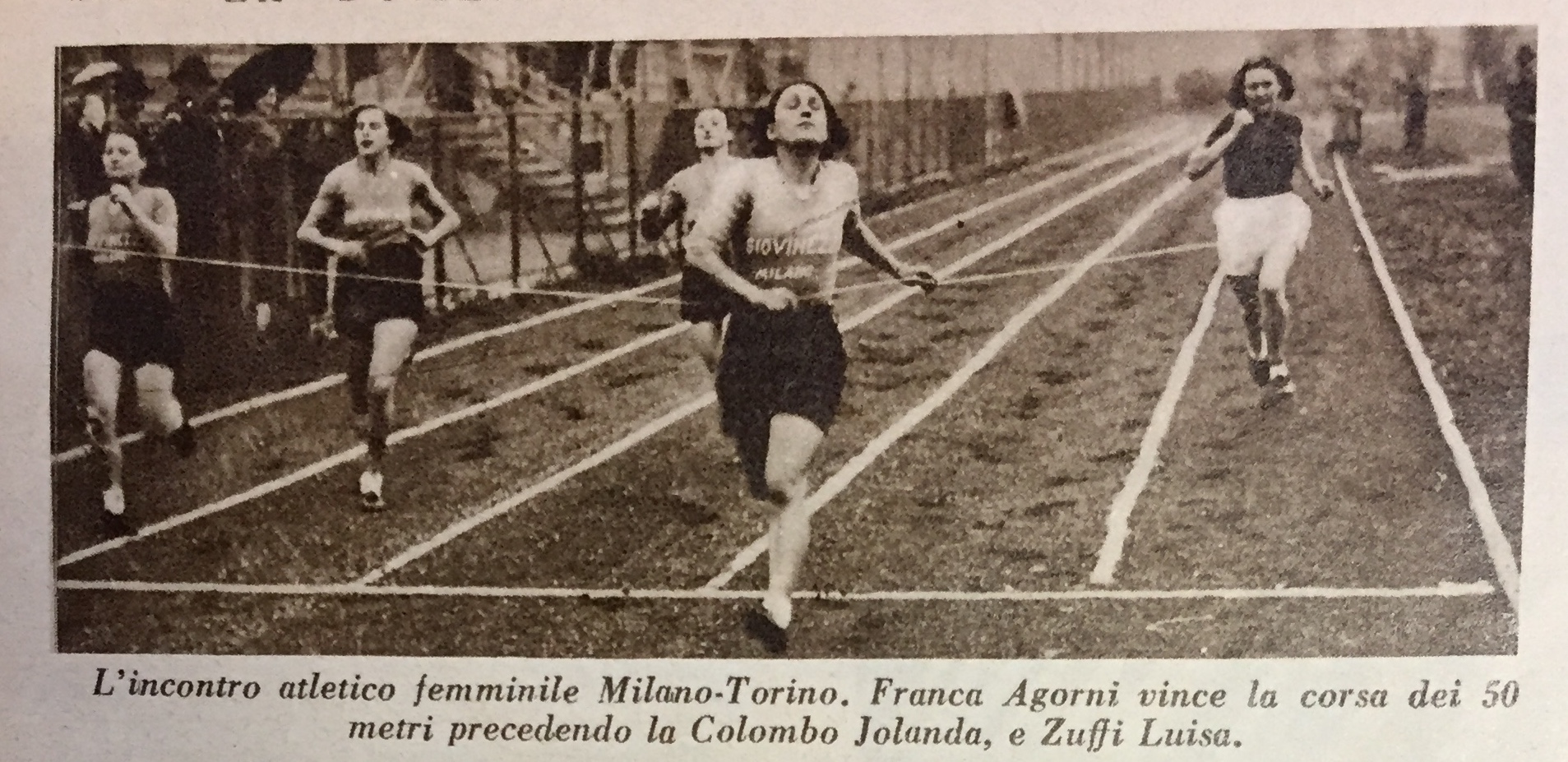
50m race, won by Franca Agorni in the rain, as it can be deduced by the umbrellas in the background, Jolanda Colombo [2nd] and Luisa Zuffi [3rd]
Source: La Domenica Sportiva, 11/11/1934, p. 12.
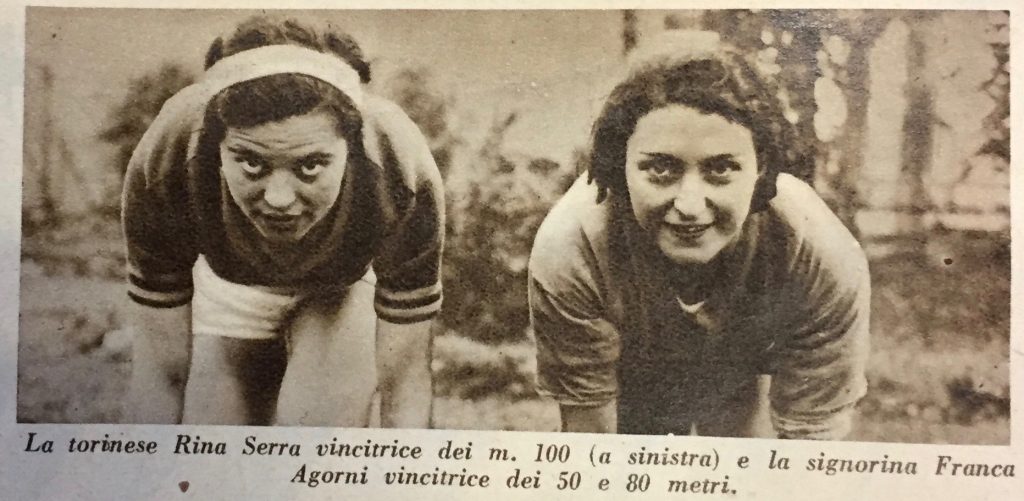
The champions of the day: Rina Serra (winner of 100m) from Turin, and Franca Agorni from Milan.
Source: La Domenica Sportiva, 11/11/1934, p. 12.
An interesting article published by Lo Schermo Sportivo [please note that Carlo Brighenti, the journalist that in 1933 wrote the first-ever report about calciatrici, was not working for this Milanese sports weekly]in late January 1935 sheds light onto the GSG organizational hierarchy. Mrs Bimbi Teruzzi was the President of GSG, assisted by Secretary Ninì Zanetti [you may remember Losanna Strigaro held this role for the GFC]. Former GFC president Ugi Cardosi was treasurer with sisters Neri and Bruna Bertolini, the acclaimed Milanese basketball players being GSG advisors. Amleto Chitti was the basketball coach, while the athletics section was led by Angelo Ferrario, a sprinter who would compete at the 1936 Berlin Olympics as member of the Italian 4x400m relay team, a member of the Pro Patria Milano sports club Ferrario was a teammate of Brunilde Amodeo’s future husband, Bianco Bracardi. Almost half of the 25 GSG members were former calciatrici: Ninì Zanetti, Maria Lucchese, Graziella Lucchese, Nidia Glingani, Maria Bedetti, Pina “Pinuccia” Leva, Lucia Grimoldi, Losanna Strigaro, Frida Marchi, Mina Bolzoni, Ellera Stroppa [Brunilde Amodeo wasn’t mentioned]. As you can see, there were no Boccalini sisters in the new sports club. Perhaps such Fascist exterior elements were too much for those left-wing former calciatrici?” Remember that ‘Giovinezza’ was the title of a famous Fascist song, used by the regime as a sort of hymn. Another interesting element, revealed by Lo Schermo Sportivo journalists, is that GSG was supposed to be the city vivaio or ‘youth academy’, training and supplying young athletes to other Milanese sports clubs. That is exactly what happened in Spring 1935, when the most promising GSG sprinters, like Franca Agorni left for Istituto Previdenza, and Jolanda Colombo, who moved to GS La Filotecnica, the new Milanese women’s sports club that would eventually subsume a lot of GSG athletes. On the other hand, new young athletes such as Gianna Rusconi from Cinisello Balsamo joined GSG. The historical sources suggest that coming from a small city in the hinterland of Milan, like Cinisello, meant that Gianna scandalized her fellow-citizens not only for racing in shorts but also for travelling to the big city of Milan, by tram AND all alone!
Meanwhile, the group was finding its place within the relatively small world of Italian women’s athletics, the key to which proved to be specialization. In March 1935 GSG successfully organized the first-ever Italian women’s cross-country championship, called Criterium Nazionale di Corsa Campestre, sponsored by FIDAL. It didn’t prove a problem that GSG was based in the urban centre of Milan, because the open spaces surrounding Città Studi were perfect for racing. Ugo Cardosi started the 1500m race in via Celoria with the finish being in Campo Giuriati. Trophies were presented by both the City Council of Milan and the Sports Office of the Fascist Federation, the race was a huge success with the Lucchese sisters eager to win and high hopes of the whole GSG.
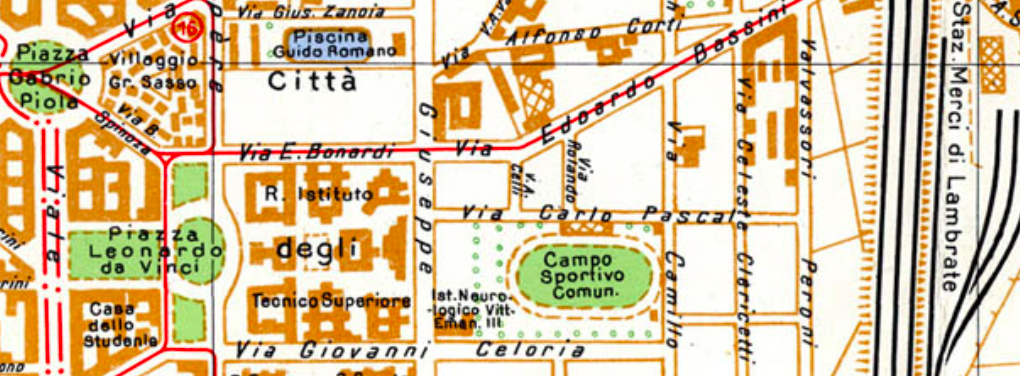
Città Studi quarter map [1937]. Campo Giurati is ‘Campo sportivo comunale’.
Note the western part of the map, towards Lambrate train station, with few buildings.
Source: http://www.stagniweb.it/mappe/Mi937.jpg .
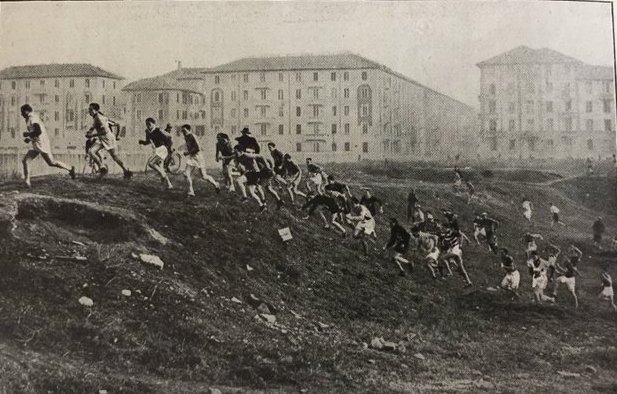
In this photo, a male cross-country race organized by a Milanese Gruppo Rionale Fascista in the northern quarter of Cagnola [1932]
Note the open fields in front of the last buildings of the city
Source: L’Illustrazione Italiana, 10/01/1932, p. 58.
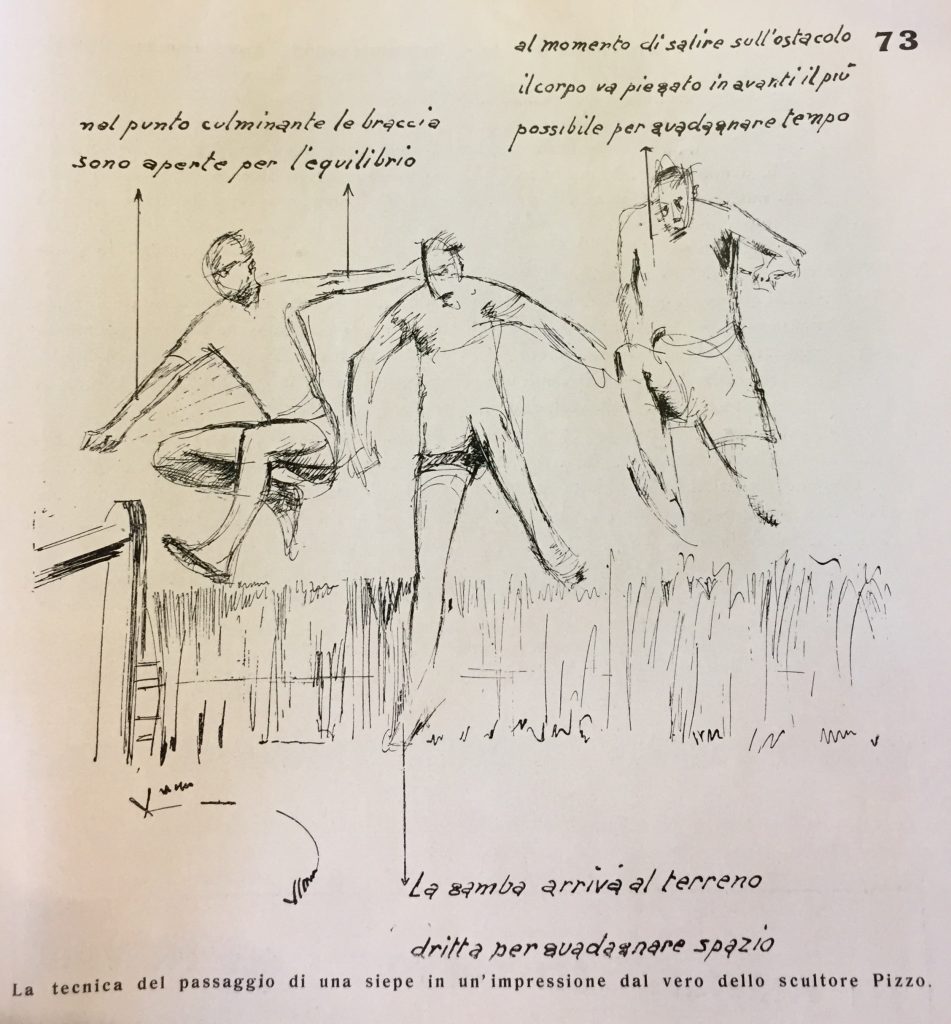
Some sketches by Pizzo showing male cross-country runners jumping a fence.
Source: Lo Sport Fascista, February 1934, p. 73.
The Lucchese sisters ran well, but they couldn’t do anything in the face of the strength and experience of their Turinese opponents, the indomitable Italian champion Leandrina Bulzacchi [GS Venchi-Unica] won the race. The first GSG athletes home were Maria Caselli [4th], Maria Lucchese [5th], her sister Graziella [7th] with former calciatrice Nidia Glingani coming in 27th and last place. In the final team rankings, GSG finished second behind GS Venchi-Unica, of course!
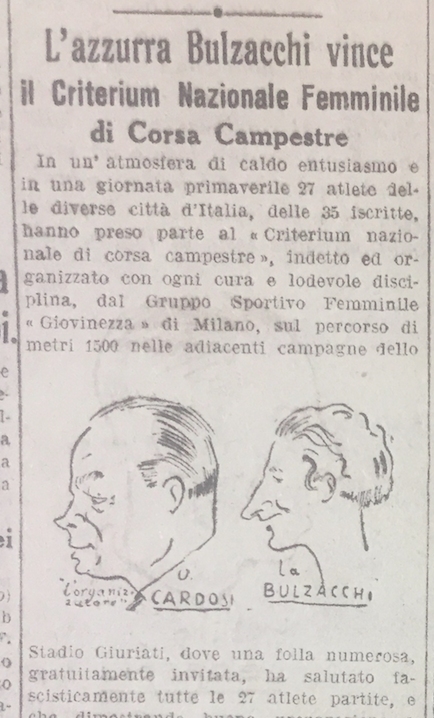
Two cartoons depicting Ugo Cardosi: ‘the organizer’ and the winning athlete, Leandrina Bulzacchi.
Note that this the first-ever image of Ugo Cardosi to be found.
Source: Lo Schermo Sportivo, 26/03/1935, p. 2.
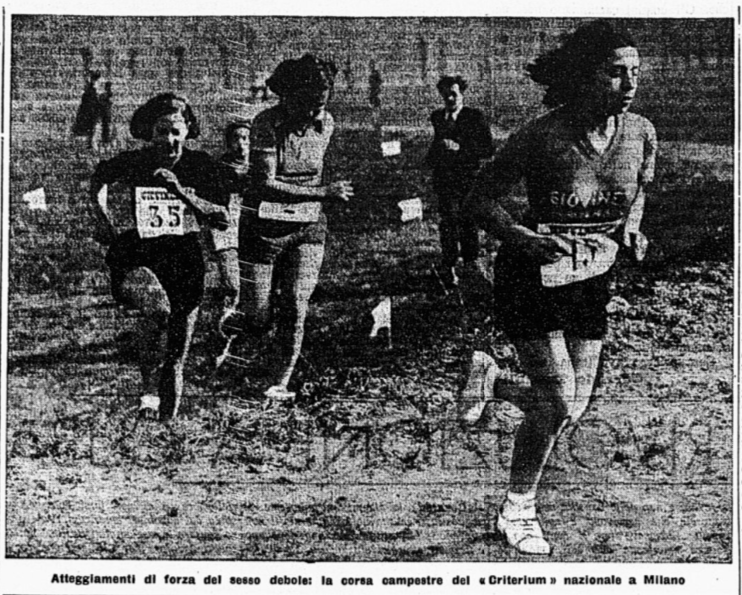
Three competitors of 1st Criterium Nazionale di Corsa Campestre: the first, on the right, is wearing a GSG shirt.
Source: Corriere della Sera, 25/03/1935, p. 4
For the remainder of 1935, GSG competed in many local and national athletics meets, with few noteworthy results [apart from the Lucchese sisters], in fact Nidia Glingani was revealed to be a modest thrower [discus and shot put] and Ninì Zanetti tried unsuccessfully to specialize in the javelin. Nevertheless, at the 1936 Italian National Championship, held in Turin, Graziella Lucchese won 800m silver with her younger sister Jolanda 6th, which represented a good result for the small Milanese sports club.
Specializing in women’s middle-distance racing was quite tricky in the middle of the 1930s, after the 1928 Amsterdam Games tiring and seemingly distressing final, the female 800m was banned from the Olympics, deemed unsuitable for women’s bodies. In 1941, an Italian sports journalist wrote that the women’s 800m should be compared to the men’s 5000m, a real long-distance run for women! Nevertheless, it was still included in the Women’s World Games, and for this reason, each country [including Mussolini’s Italy] needed to train some female athletes for this discipline. Leandrina Bulzacchi [who, according to 1934 article by La Stampa was a mill worker by day in contrast to Ondina Walla who had an ‘easier’ clerking job] was the unbeatable national champion at the time, always being chosen for any international meeting as a member of the Italy athletics squad. Male and female cross-country events were ideal to give middle distance runners an opportunity to train during the winter, the women ran over a distance of between 1100m-1500m, the most challenging event a female athlete could undertake in Italy at that time. By a sheer twist of fate, in the same years [as Gherardo Bonini has pointed out in a 2018 Playing Pasts article, see bit.ly/2N052v1] Edith Klinger was doing quite the opposite in Austria, turning middle-distance runners such as Josefine Lauterbach, the Austrian 1928 800m Olympian, into footballers! Klinger was sure that:
‘if women who played football were proven athletes, they could also quickly make up for deficiencies in the control of the ball in football and also make those athletic clashes that men claimed they could not do’.
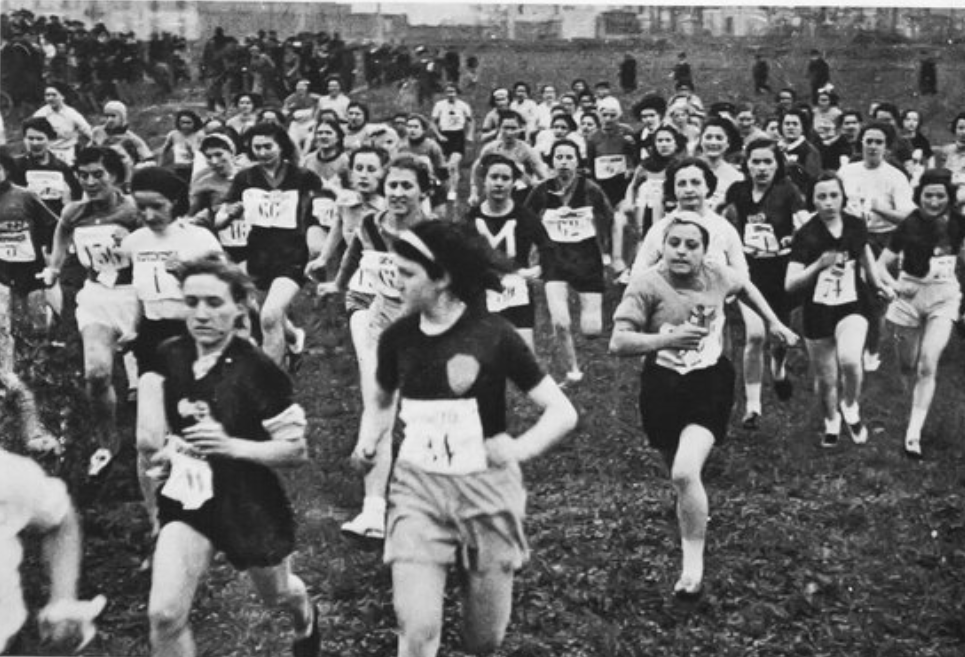
Leandrina Bulzacchi [dark shirt, on the left] during the start of a cross-country in Milan [1937].
Source: Lo Sport Illustrato, 17/03/1937, p. 14.
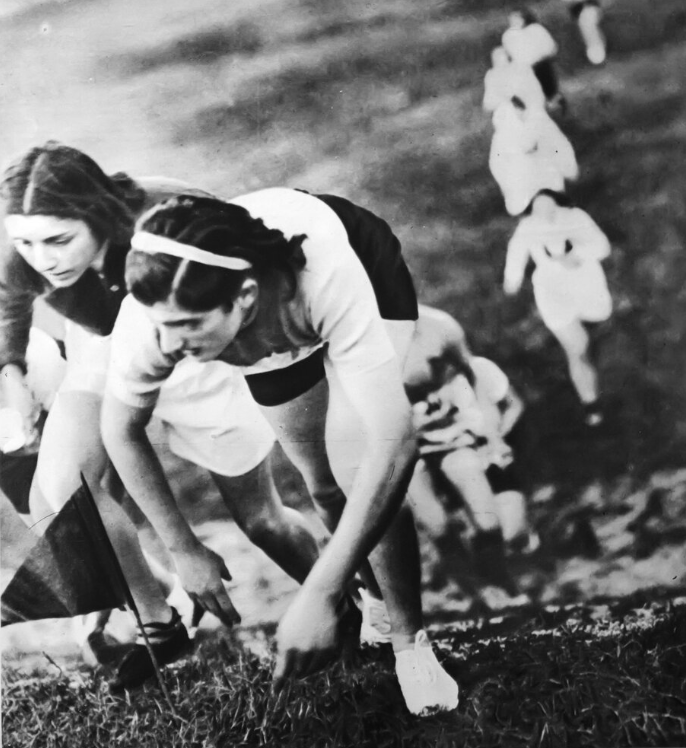
Little flags pointed out the mid-point of a cross-country race. Original caption says: ’30 girls, who don’t fear the cold, briskly raced, forgetting [at least, for a little while] powder and lipstick’.
Source: Lo Sport Illustrato, 13/01/1937, p. 16.
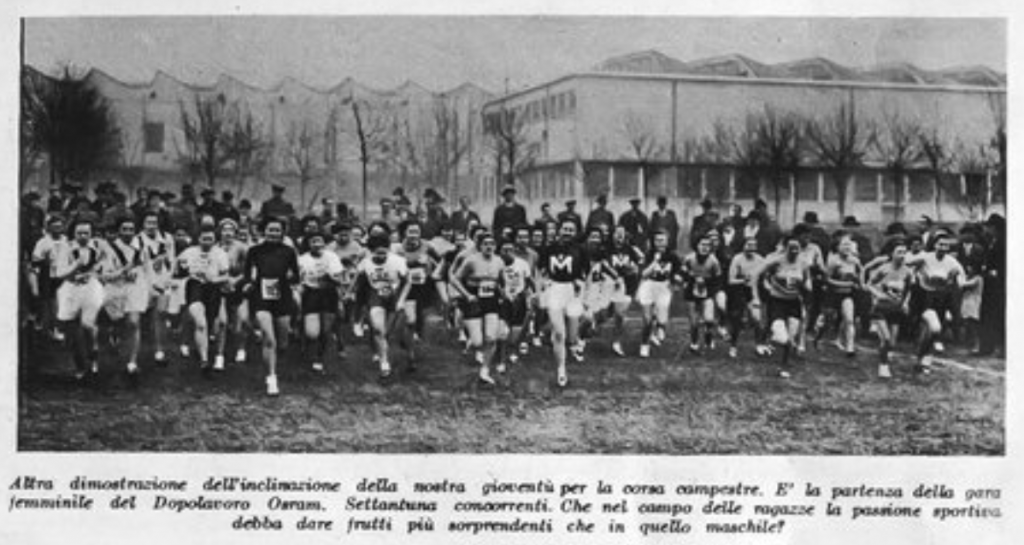
Note the mill in the background. Most of time, cross-country events were organized by the Dopolavoro ‘company sports club’, because of their popular profile.
Source: Lo Sport Illustrato, 11/01/1937, p. 13.
On 22 September 1935, during a small athletics meeting between GSG and Guf Brescia, Graziella Lucchese, together with the Turinese athletes Leandrina Bulzacchi and Cleo Balbo, was called upon to try and break the 3x800m women’s world record [7′ 37”], which had been held by Germany since 1933. Although the team did manage to establish a new Italian record, lowering the mark from 8′ 20” to 7′ 45”, Graziella, Leandrina and Cleo failed to set a new world record by just 8 seconds. The Milanese athletes further missed out on glory, when two years later, on 29 June 1927, Leandrina Bulzacchi, Cleo Balbo and her GS Venchi-Unica teammate Candida Giorda succeeded and broke the world record, setting a new time of 7′ 32’’
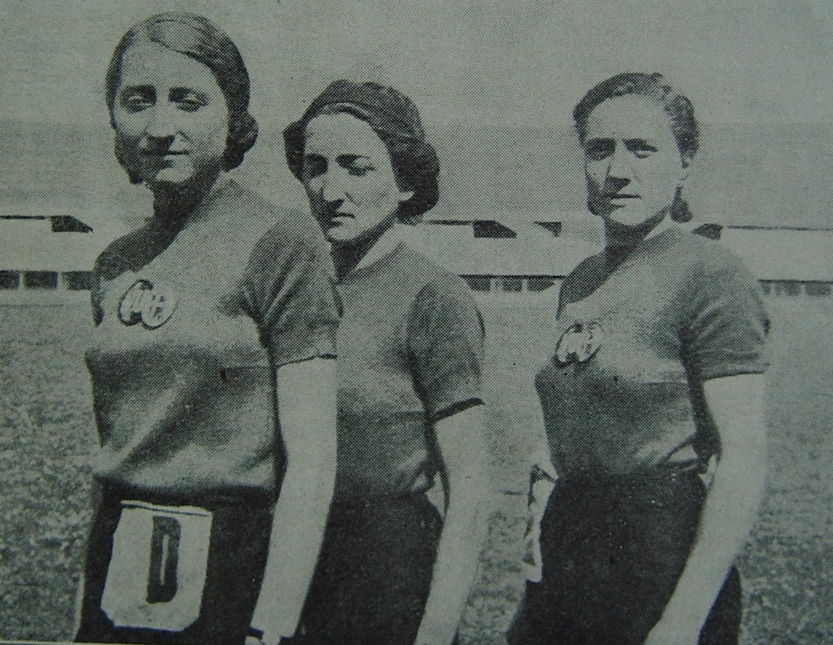
The GS Venchi-Unica team which established the new 3x800m world record in 1937: Cleo Balbo, Candida Giorda, Leandrina Bulzacchi.
Source: Wikipedia (http://bit.ly/2wKts3I )
At the beginning of 1936, Lo Schermo Sportivo published another article about the GSG organisation. Starting from the management, president Bimbi Teruzzi was now supported by Countess Luisa Majnoni with Ninì Zanetti being no longer mentioned, either as an athlete or within management circles, while Ugo Cardosi and the Bertolini sisters remained within the organisational hierarchy. Among the 22 athletes, there seemed to have been a lot of replacements, however, the three Lucchese sisters (Maria, Graziella and Jolanda) numbered among a few members of the old guard who remained, perhaps understandable if we think about GSG as the vivaio of the Milanese women’s athletic movement. The Lo Schermo Sportivo journalist, in contrast, suggested that during the first 14 months about 70 sportswomen moved from GSG, the usual free membership and kit were meant to be hints of the apprenticeship nature of GSG. There seems to be no more reports of any basketball activity by GSG from 1936.
On 8 March 1936 the 2nd edition of Criterium Nazionale Femminile di Corsa Campestre took place. Campo Giuriati being both the start and finish of the 1500m race organized by GSG. As expected Leandrina Bulzacchi won the race, with Graziella Lucchese claiming silver and her sister Jolanda finishing in 5 th place; this time, GSG won the Targa del Duce, but as Bulzacchi seems to have been one of the few elite participants, this team victory doesn’t rate as a big triumph.
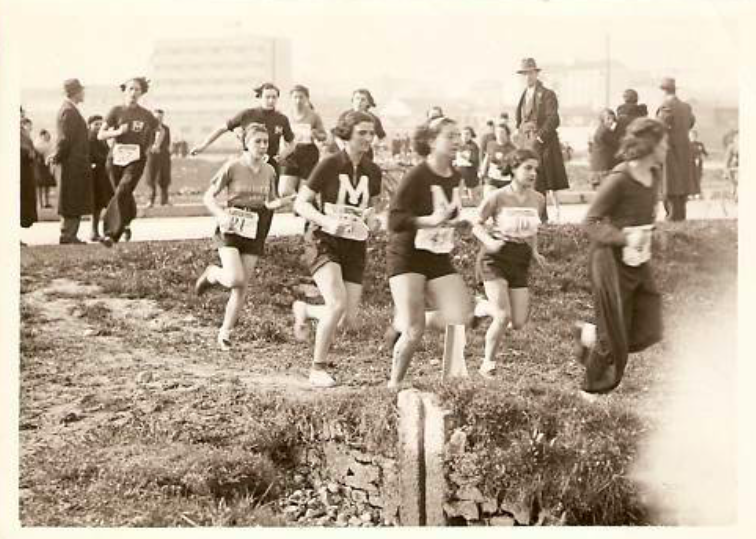
A picture from 1936 Criterium Nazionale: with athletes from GSG and Guf Milano, in the black shirts
Source: https://bit.ly/2VAyEnS
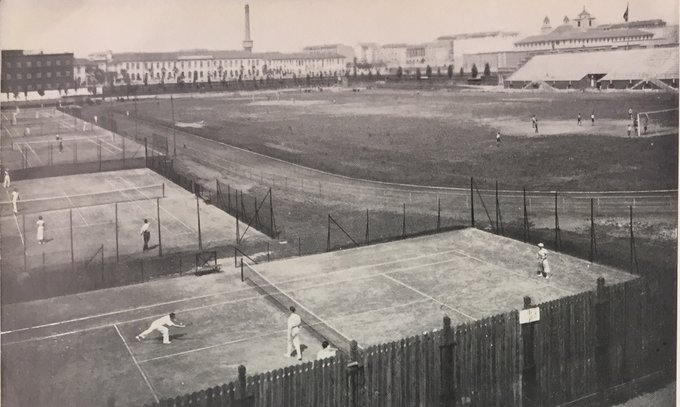
Campo Giuriati, Milan.
Source: https://bit.ly/3eT0IdF
During the 1936 season, GSG took part in fewer athletics events than the previous year, the two younger Lucchese sisters [Graziella and Jolanda] were the only two athletes to win medals. The 1936 Italian National Championship took place in Milan, on Sunday 5 July, organized by the local Guf ‘Ugo Pepe’. Despite the ‘home-like’ location of the Forza e Coraggio sports centre, it turned into a complete debacle for GSG, who wasn’t able to finish in the first 6 positions of the final team ranking. Graziella Lucchese won 800m silver with her sister Jolanda being 4th and Ninì Zanetti came back to compete in a GSG shirt, but her performance in pentathlon was a complete disaster, finishing 6th of 6 in almost every event of the competition. The winners of the day, such as Ondina Valla [100m] and Claudia Testoni [80m hurdles] were preparing for the Berlin Olympics, held later that year, but Leandrina Bulzacchi, who once again won the 800m gold, wouldn’t join the Italy team, since women weren’t allowed to compete in the ‘dangerous’ discipline at the Olympiastadion.
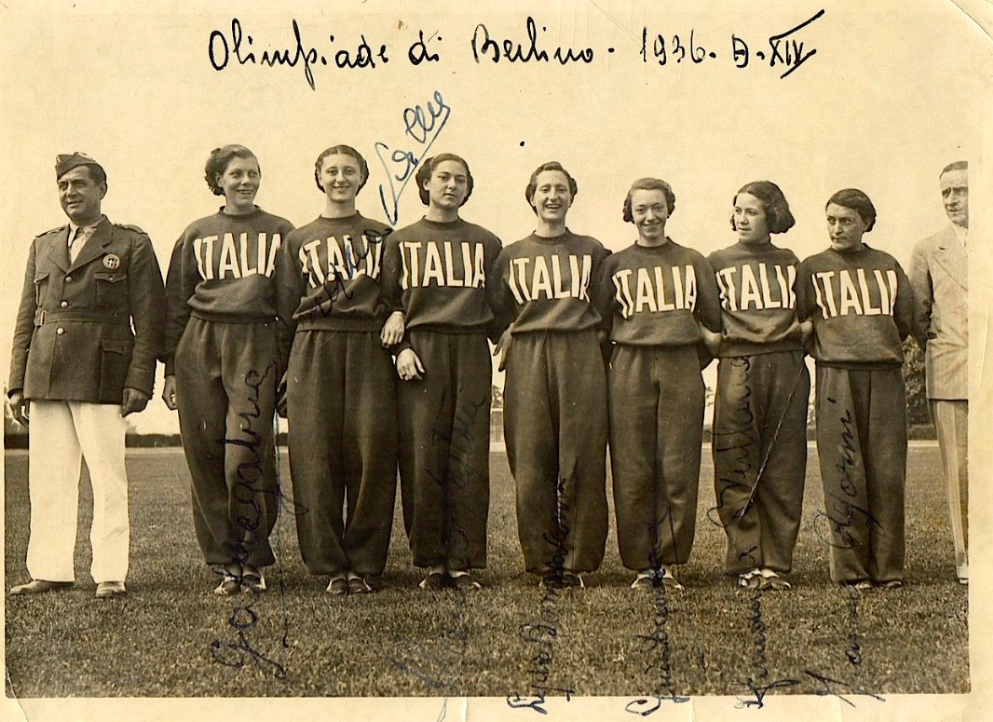
Franca Agorni, former GSG sprinter – At the 1936 Olympics she was a member of Italy women’s athletics team [reserve for 4x100ms squad], she didn’t race and can be seen in this photo, first right, posing with her teammates in Berlin.
Source: https://twitter.com/calciatrici1933/status/1051408530404765696
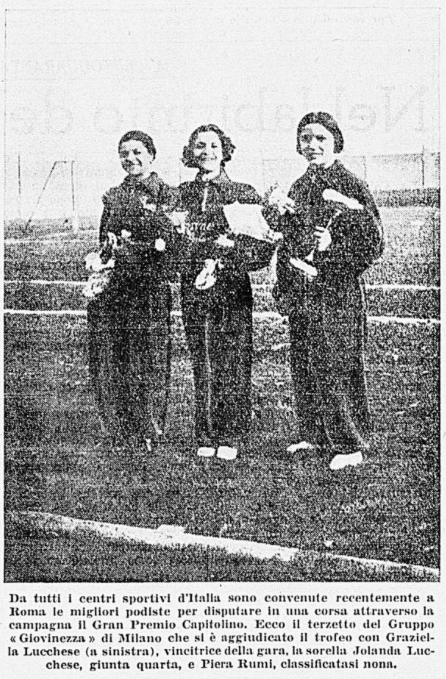
GSG athletes in Rome, after Gran Premio Capitolino race [January 1937]: Graziella Lucchese (1st), Jolanda Lucchese (4th), Piera Rumi (9th)
Source: Corriere Della Sera, 28/01/1937, p. 4.
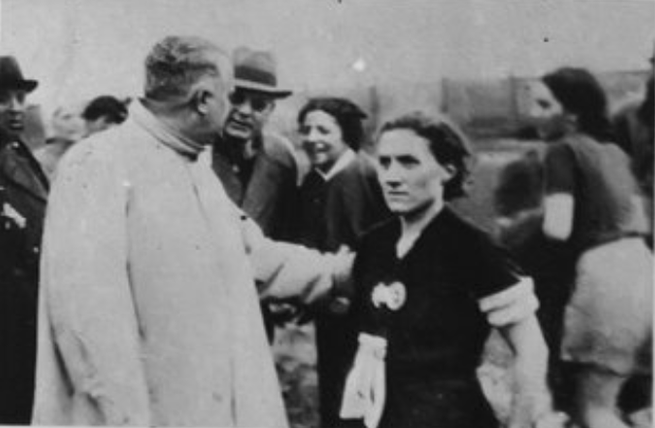
Giorgio Vaccaro, Secretary of CONI, congratulating Leandrina Bulzacchi, winner of 3rd Criterium Nazionale
Source: Sport Illustrato, 14/03/1937, p. 14.
At the 1937 Italian National Championship, held in Piacenza on 1 August 1937, the Lucchese sisters realized that the clock was ticking, not only for their eldest sister Maria, who had already stopped her sporting activity, but for them all. Maria in fact would marry her former GFC trainer Piero Cardosi on 28 October that year and thus became the daughter in law of Ugo Cardosi. Graziella and Jolanda ranked just 5th and 6th in the 800m, with a new generation of female middle-distance runners rising through the system. At the 1940 Italian National Championships, 16-years-old Galimberti would set a new national record of 2′ 24’’, breaking Cleo Balbo’s previous mark.
Crushed by local competition from GS La Filotecnica, GSG had little reason to carry on, so in late November 1937 the club was incorporated into Dopolavoro Aziendale Caproni [DAC], the workers’ sports society of Officine Caproni, the most important company in the Italian aircraft industry, located in the Taliedo quarter of eastern Milan [what is now Linate International Airport]. Corriere della Sera wrote that, in a kind of symbolic face-to-face handover, the 30 remaining GSG athletes were introduced by Countess Majnoni to the president and founder of DAC, Gianni Caproni together with his wife Timina Guasti Caproni, the DAC patroness.
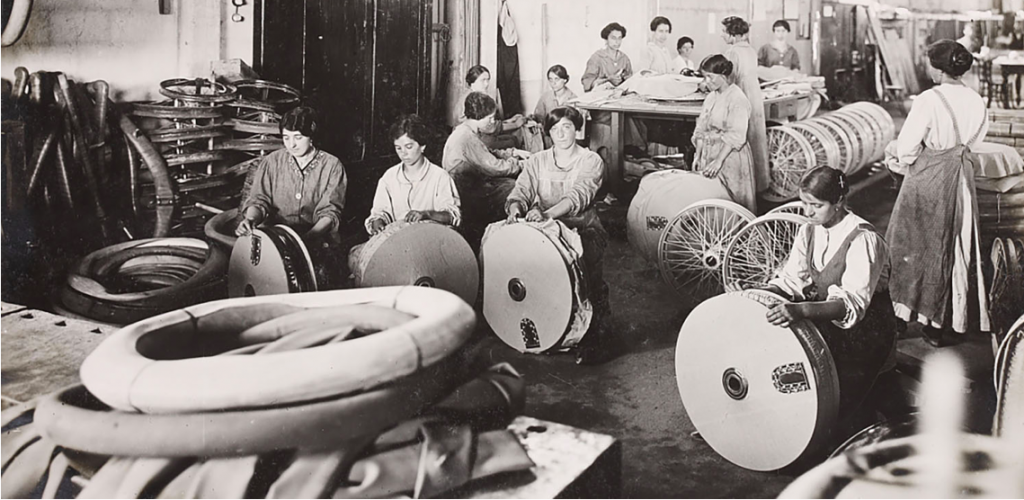
Officine Caproni female workers
Source: http://www.officinedelvolo.it/storia
-
Timina Guasti and Gianni Caproni, circa 1940
Source: https://bit.ly/2BVF6Pn
-
Timina Guasti Caproni, circa 1940
Source: https://bit.ly/2VCER2v
Not surprisingly, in January 1938 the DAC organized a small women’s cross-country event. As an unpublished document from Forza e Coraggio archive reveals, Mr Cardosi [almost certainly Ugo, who thanks to GSG had gained huge experience in the management of amateur sports] was in the DAC hierarchy, being one of two heads of the Athletics section. The 1000m cross-country race, scheduled for 30 September 1938, was just for the amateur worker athletes, thereby marking the end of the Italian-wide glorious deeds of GSG’s Criterium Nazionale.

The programme from the January 1938 cross-country event organized by DAC, Cardosi’s name is the bottom
Source: Archivio Forza e Coraggio (Milan), 1.3.3.3/16 (b. 31)
Courtesy of Prof. Virna Duca (Forza e Coraggio’s Direttore Generale).

In 1929, an Italian sports magazine published this women’s cross-country photo, coming from France as almost a rare image
Source: Gran Sport, April 1929, p. 57.
Wearing the DAC shirt, Graziella Lucchese finished 5th in the 800m at the 1938 Italian National Championship held in Parma. In the following years, as Italy became embroiled in WW2, the small DAC seemingly left no trace in the history of Italian women’s athletics: nevertheless, it was able to write a belated, if surprising ‘page’, in the annals of Italian women’s sports history. In October 1942 the first-ever Italian Women’s Field Hockey Championship took place in Modena: the 4 teams were Guf Modena, Guf Genova, Gil Genova, and … DAC!
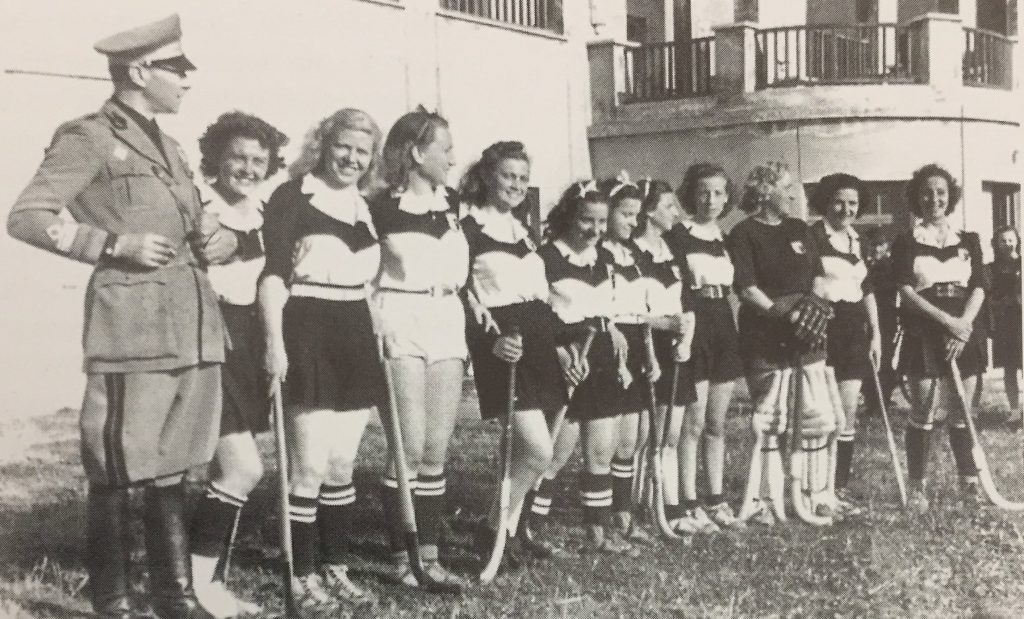
One of the first women’s field hockey team in Italy
Source: https://bit.ly/2CQHsPZ .
Historical sources fail to mention the names of the Milanese players, with Il Littoriale praising just the captain Ronzoni, who led her teammates to an honourable defeat against their Genoese opponents. Among them some old GSG athletes, or even GFC footballers, ready to embark on this, their last sporting adventure, as Fascist Italy would soon collapse, and those Caproni airplanes would prove no longer useful? Will further historical sources be able to help us to answer such a question?
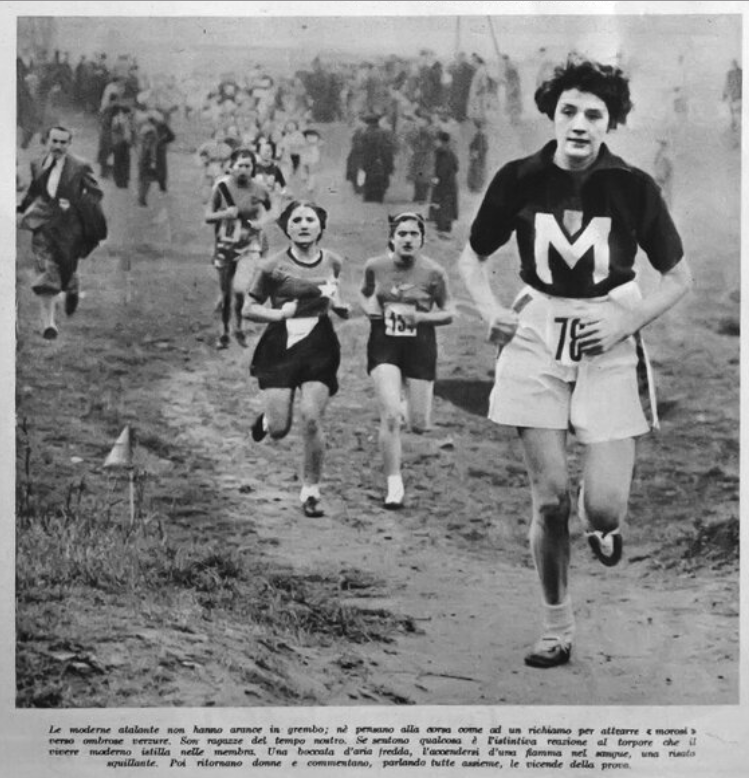
Original caption talks about the cross-country runners as ‘modern Atalantas’, who are not eager to catch golden apples and thereby a husband [such as in the Greek myth]: rather they make do with a bit of fresh air, that can move them away from their daily sedentary life
Source: Lo Sport Illustrato, 11/01/1937, p. 13.
To read the follow up article by Marco – The Eternal Seconds of Italian Women’s Athletics: The History of Gruppo Sportivo La Filotecnica [Milan, 1935-1943] – Click HERE
Article © Marco Giani
For more sources about Gruppo Sportivo Giovinezza:
For more sources about women’s basketball in Milan during the Fascist regime:
For a gallery about GSG:
https://twitter.com/calciatrici1933/status/1121385223051206658
For a gallery about women’s 800ms race in 1930s’ Italy, see
https://twitter.com/calciatrici1933/status/1043798926967672832
For a gallery about men’s cross-country in 1930s’ Italy, see:
https://twitter.com/calciatrici1933/status/1008830874643828736
For a gallery about women’s field hockey in 1930s’ Italy, see
https://twitter.com/calciatrici1933/status/1020411036837478401

![Switching from Women’s Football to Cross-Country: <br>The History of Gruppo Sportivo Giovinezza [Milan, 1933-37]](https://www.playingpasts.co.uk/wp-content/uploads/2020/07/PP-banner-maker.jpg)
